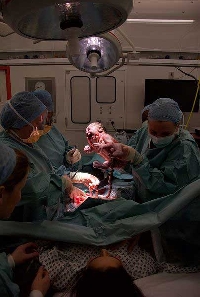caesarean births or natural !
Launch gallery slideshow

| Swap Coordinator: | reauk (contact) |
| Swap categories: | |
| Number of people in swap: | 4 |
| Location: | International |
| Type: | Type 1: Electronic |
| Last day to signup/drop: | June 14, 2013 |
| Date items must be sent by: | June 21, 2013 |
| Number of swap partners: | 10 |
| Description: | |
|
talking about pregnancy did you have a normal birth or a caesarean births? I have had four caesarean births...were you asleep or awake? I was asleep for two births and awake for the other two so I saw them been born and pulled out it was amazeing. hope you join this swap and exchange storys you can pm or e/mail your answers... its not as gory as you think few tweaks and pulls and presto a beautiful baby in your arms, What is a Caesarean section? Getty - Caesarean In some situations a Caesarean may be the only safe option for mother and baby. Even though a vaginal delivery is the most common way to give birth, a Caesarean section is often advised and performed in certain situations. The relative safety of Caesarean sections has seen a rise in the number of babies being delivered in this way. Most maternity units in the UK deliver between 10 and 20 per cent of babies by Caesarean section. A Caesarean may be planned in advance (elective section) or be performed at short notice, particularly if there are complications or difficulties in labour (emergency section). An elective Caesarean section is performed one to two weeks before the baby's due date. This ensures the baby is mature before delivery. If performed at 38 weeks, the risk of the baby's lungs not being mature is two in a 1000 but at 39 weeks it is one in a 1000. When is a Caesarean necessary? In some situations a Caesarean may be the only safe option for mother and baby, for example when: the placenta lies so low in the uterus that it covers the exit to the birth canal (cervix) – known as placenta praevia the obstetrician finds out that the baby's health is threatened due to lack of oxygen there is vaginal bleeding and a natural delivery is not going to happen the umbilical cord falls forward and the baby cannot be delivered easily (a condition known as cord prolapse) it becomes clear during labour that the mother will be unable to deliver the baby herself. In other situations, a Caesarean may be considered the safest option even though a vaginal birth is a possibility: if the baby is lying with its head upwards (breech baby) if the mother is affected by high blood pressure or another illness if the unborn baby is too small or too weak to survive a natural birth – there's no advantage if the baby's weight is over 1000g for a cephalic presentation (head first) and over 1500g for a breech birth if the mother has had a Caesarean birth before (although it is possible for a mother who's had a Caesarean to have a vaginal delivery in a later pregnancy) in rare cases, when the mother is so anxious about the delivery that a Caesarean is considered. If you wish to have a Caesarean section, you should discuss your reasons with your obstetrician. Often the reasons for requesting a Caesarean can be resolved without the need to perform a Caesarean section. What happens during a Caesarean? After you have been prepared (eg had nothing to eat or drink for six hours) and consented – you will be anaesthetised. This is usually a local anaesthetic rather than a general anaesthetic. Your partner can be present if the operation is being carried out under a local anaesthetic – spinal or epidural anaesthetic. You are rolled slightly onto your left with a drip in your arm giving you fluid and a catheter in the bladder. Your stomach is cleaned with an antiseptic and draped. Once anaesthetised, the surgeon makes a 15cm incision in the bikini line. The layers of tissue are opened to access the womb, which is cut in the same direction to deliver the baby through the incision and onto the abdomen. The midwives and nurses assist, the baby is passed to the paediatrician (the baby's specialist) to be checked over. After the placenta (afterbirth) is delivered, the obstetrician closes the incision. Dissolving stitches or staples are used to close the skin. From beginning to end, an uncomplicated Caesarean will take between 20 and 30 minutes. What will I feel during the Caesarean? Most anaesthetists will perform a spinal or epidural anaesthetic using a fine needle placed midway down the spine. You will experience some feeling of pressure during the Caesarean, but will not feel pain. A general anaesthetic may be advised under certain circumstances. This is when you are made unconscious. What are the risks of Caesarean section? A Caesarean section is a safe operation for you and your baby. However, as with any major surgery, there are risks involved. Women who are obese, have had previous surgery or a medical conditions have an increased risk of complications. Complication rates from a planned (elective) Caesarean section are less than those performed as an emergency. Risks to the mother Seven will need an emergency hysterectomy. Five will need further surgery at a later date. Nine will need admission to an intensive care unit (highly dependent on reason for caesarean section). Two will have thromboembolic disease. One will have a bladder injury. 0.3 will have a ureteric injury. Death occurs in one woman in every 12000. Common complications during the birth (out of 1000) 20 babies may sustain a scratch or small lacerations from the surgery. Future pregnancy risks (out of 1000) Seven will have an increased risk of uterine rupture during subsequent pregnancies/deliveries – so a repeat Caesarean should always be offered for future deliveries. Four will have a problem with the placenta stuck to the uterus in subsequent pregnancies. Common complications after birth (out of 1000) 90 experience wound discomfort for two months after surgery. 25 will need a repeat Caesarean section when a vaginal delivery is attempted in subsequent pregnancies. Five will have heavy bleeding or haemorrhage. 60 may have signs or evidence of an infection. What happens after the Caesarean? Most women are up and about within 24 hours of a Caesarean. Pain from the wound is controlled with appropriate painkillers. Most mothers leave hospital four or five days after a Caesarean birth. A Caesarean section should not prevent a mother from breastfeeding her baby. Future pregnancies may also need to be delivered by Caesarean section because some indications for the original Caesarean persist into subsequent pregnancies. However, 75 per cent of women will be able to have a vaginal birth next time | |
Discussion
Leave a Comment
You must be logged in to leave a comment. Click here to log in.
- Info:
- Home
- |
- About
- |
- Forum Rules
- |
- Terms of Use
- |
- Press
- |
- Advertising
- |
- Blog
- |
- Graphics & Stuff
- Help:
- New User Info
- |
- FAQ
- |
- Group Info
- |
- Glossary
- |
- Forums
- |
- |
- Contact Admin

